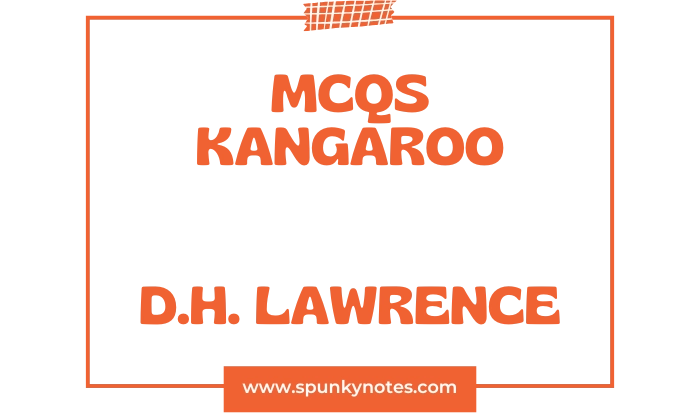

Estimated Reading Time: 17 min
Kangaroo MCQs
1. What season was it when the Somers arrived in Sydney?
A. Mid-spring
B. End of May/Winter
C. Mid-summer
D. Early autumn
2. What did the stranger quote as the correct tariff for the bags?
A. A shilling
B. A penny
C. Threepence
D. A sixpence
3. What name was printed on one of Mr. Somers’s bags?
A. D.H. Lawrence
B. R.L. Somers
C. Jack Callcott
D. B. Cooley
4. How did Mr. Somers feel about the Australian concept of freedom regarding payment?
A. It granted equality
B. It was fair to the worker
C. It meant being forced to pay
D. It allowed free negotiation
5. What did Harriet say the house name, “Torestin,” actually meant?
A. Must be Russian
B. Must be native word
C. It meant “To rest in”
D. It was meaningless
6. What piece of furniture covering did Harriet remove immediately upon entering?
A. A sheepskin rug
B. The red plush tablecloth
C. A lace doily
D. An Indian sarong
7. What was the most prominent negative feature of the suburbs, according to Harriet?
A. Brick houses
B. Corrugated iron and fences
C. Tudor manors
D. Tall hedges
8. What was R.L. Somers’s primary source of income?
A. Investments
B. Writing poems and essays
C. Working as a mechanic
D. Farming
9. What made the Southern night-sky feel alienating to Somers?
A. The heat
B. The Southern Cross was inconspicuous
C. The lack of stars
D. The heavy cloud cover
10. Who was the female neighbour who first spoke to Harriet?
A. Rose Trewhella
B. Mrs. Callcott (Victoria)
C. Mrs. Somers (Harriet)
D. Gladys
11. What kept Australia from anarchy, according to Somers’s cogitation?
A. Economic stability
B. The name of England/Authority
C. Strong local laws
D. The temperament of Australians
12. What was the heavy chunk of lead from Jack’s war wound mounted on?
A. A brooch
B. A hatpin
C. A toy lamp-post
D. A necklace
13. What did Somers note was absent in Sydney?
A. Outer suburbs
B. Irresponsible freedom
C. Any core or pith of meaning
D. Tall buildings
14. Who was Mrs. Callcott’s sister married to?
A. Alfred John Trewhella
B. William James Trewhella
C. Jack Callcott
D. R.L. Somers
15. What physical feature of Jack Callcott did Somers note as having an “aboriginal darkness”?
A. His hair
B. His eyes
C. His hands
D. His beard
16. What type of physical contact made Richard Lovat feel “isolated” and wary of Jack?
A. The strange smile
B. Calling him “mate”
C. Being touched or hugged
D. Arguing about politics
17. How did Somers describe the communication style among the common people/Australians?
A. Intentional and formal
B. Silent and involuntary
C. Always foiled by speech
D. Entirely based on talk
18. What did Jack suggest was the “bogey of to-morrow”?
A. Foreign powers
B. The money-men
C. Labour
D. Anarchy
19. What was R.L. Somers’ income?
A. A hundred pounds a year
B. Four hundred pounds a year
C. Seven hundred pounds a year
D. Very little income
20. What did Harriet feel when she was alone in Australia, before the stress?
A. Overwhelmed by silence
B. Free, like a fish in a crystal ocean
C. Frightened by the bush
D. Lonely and anxious
21. What did Somers compare the feeling of being in Kangaroo’s presence to?
A. Being cuddled on his ample breast
B. Being embraced by a tyrant
C. Being stalked by a tiger
D. Being lectured by a fool
22. What did Jack confess he did to the man who shot Kangaroo?
A. Nothing, he fled
B. Shot him back
C. Smashed his brains out
D. Helped the police arrest him
23. What philosophical state did Somers briefly enter while walking in the bush?
A. Rage
B. Semi-consciousness/saurian torpor
C. Enlightenment
D. Intense love
24. What did Somers feel he must still fight out with mánkind?
A. A political cause
B. The struggle for a new life-form
C. A revolution
D. The battle for money
25. What did William James Trewhella claim Australia was meant for?
A. Artists
B. Superior people
C. One dead level sort of people
D. Foreign immigrants
26. What did Somers admire about the Colonials when they spoke seriously?
A. They spoke like academics
B. They spoke like men
C. They spoke eloquently
D. They spoke courteously
27. What action did Jack perform, emphasizing his trust and conspiracy with Somers?
A. Gave him a secret handshake
B. Clasped his hand and put his arm around him
C. Gave him a secret map
D. Told him Kangaroo’s plans
28. What reason did Jack give for why they called Ben Cooley “Kangaroo”?
A. He jumped a lot
B. He looked like one
C. He wore a pouch
D. He owned kangaroos
29. What ethnicity did Somers suspect Kangaroo belonged to?
A. German
B. Irish
C. Italian
D. Jewish
30. What did Kangaroo define as the one and only inspiration of all creative activity?
A. War
B. Reason
C. Love
D. Money
31. What did Richard Somers say Kangaroo worked everything from?
A. The stomach
B. The spirit/head
C. The lower self
D. The feet
32. What word did Richard use for the “dark self” or “lower self”?
A. Spiritual
B. Phallic
C. Rational
D. Unconscious
33. What did Kangaroo threaten to do to Somers if he continued to deny his love?
A. Leave Australia
B. Exorcise the demon in him
C. Ignore his politics
D. Write a bad review
34. What was the derogatory term used for newcomers from the Old Country?
A. Limey
B. New Chum
C. Pommy
D. Aussie
35. What word, better than ‘courage,’ did Somers adopt as his motto?
A. Love
B. Virtus/Mut (Manliness)
C. Destiny
D. Freedom
36. What did Somers realize about the feeling of fear returning in Mullumbimby?
A. Fear of the sea
B. Fear of the mob/democratic society
C. Fear of the wild animals
D. Fear of poverty
37. What did Kangaroo accuse Somers of doing to him, resulting in his illness?
A. Betraying him
B. Lying
C. Killing him
D. Spying
38. What did Kangaroo ask Somers to say before he died?
A. Say you will leave Australia
B. Say you believe in the cause
C. Say you love me
D. Say you will follow me
39. What mythical, crowned bird did Somers use to symbolize the new flag of their marriage?
A. Pegasus
B. Phoenix
C. Swan
D. Unicorn
40. What was the final destination that Somers felt compelled to sail towards in his marriage?
A. To a safe harbor
B. Into uncharted seas
C. Back to England
D. To Tahiti
41. What animal did Richard compare himself to, isolated among men?
A. Kangaroo
B. Emmu
C. Snake
D. Dingo
42. What was the name of the new squad members in the Digger Movement?
A. Maggies
B. Emu Guards
C. Roos
D. Socialists
43. What did Jack ultimately want for Australia, away from world-boost?
A. A large empire
B. A cosy, lively little Australia
C. A communist state
D. A monarchy
44. Who was the red-faced, dark, thin man who resembled Abraham Lincoln?
A. Jack Callcott
B. William James Trewhella
C. Willie Struthers
D. Ben Cooley
45. What did Somers claim the masses of people were like, due to their industrial nature?
A. Machine people
B. Gentle sheep
C. Lost lambs
D. Quiet philosophers
46. What did Somers refuse to accept, causing conflict with Kangaroo?
A. Kangaroo’s political strategy
B. Kangaroo’s love
C. Kangaroo’s job
D. Kangaroo’s house
47. After the war memories resurfaced, what did Somers feel he was broken off from?
A. His family
B. His career
C. His fellow-men and England
D. His old house
48. What did the denial of the spontaneous soul create, according to Somers?
A. A great fortune
B. The reflex of its own revenge
C. A new religion
D. Peace
49. What did Somers feel he was drowning in, wanting to crawl out?
A. The merge of harmlessness/sympathetic humanity
B. The deep sea
C. The Australian bush
D. The crowd
50. What type of item broke and fluttered away, symbolizing broken attachments, as the ship left Sydney?
A. Cables
B. Orange silk kerchiefs
C. Streamers
D. Ropes
Brief Overview
Kangaroo is a novel by D. H. Lawrence, set in Australia during the 1920s. It follows an English writer named Richard Lovat Somers and his German wife, Harriett. They move to Sydney, hoping to find a new, simpler life after the trauma of World War I.
Soon, Somers meets a man named Ben Cooley, who is nicknamed “Kangaroo.” Kangaroo is the powerful leader of a secret, right-wing political group made up of ex-soldiers. He is a charismatic but strange figure who wants Somers to join his movement and use his writing skills for their cause.
At the same time, Somers is also approached by a rival left-wing group, led by the socialist Willie Struthers. Both groups try to pull Somers into their political conflicts, demanding his loyalty. Somers, however, is a strong individualist and struggles to commit to any group’s ideology.
The novel includes long chapters where Somers thinks about his life, his marriage, and his philosophy. He also includes a terrible flashback chapter, “The Nightmare,” which details his wartime persecution in England. The story’s climax is a violent political riot in Sydney, which Somers witnesses.
Somers feels caught between these two extreme forces and ultimately refuses to choose a side. Disappointed by the political violence and the pressure to conform, he and Harriett decide to leave Australia. They sail away, still searching for a place where they can truly belong.


